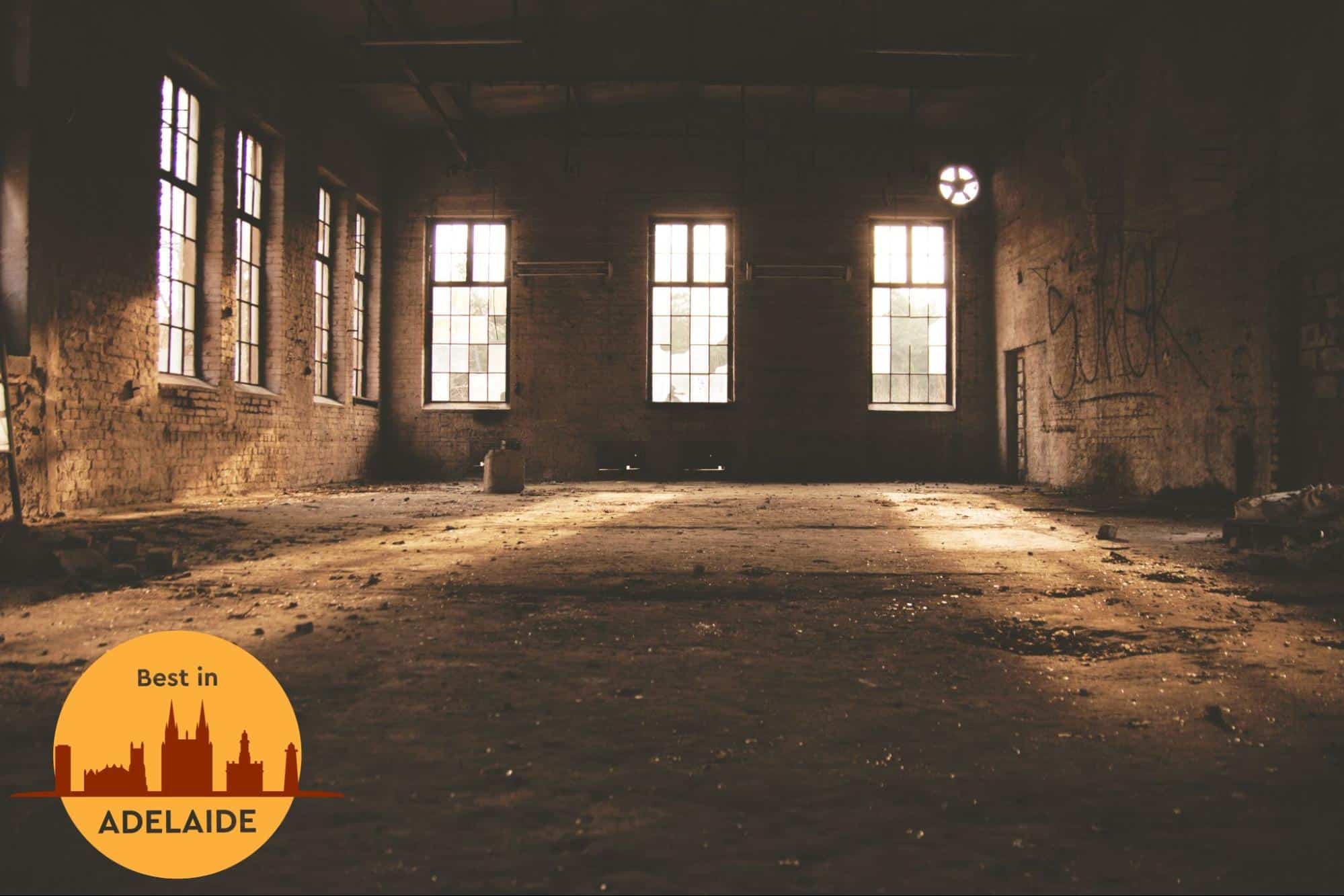
Deserted Discoveries: Abandoned Places in Adelaide
Adelaide’s abandoned places is a dusty yet fascinating window into the city’s past, revealing a unique blend of history and mystery.
We explored these deserted sites, and stories unfolded before our eyes, from tales of forgotten WW2 radar stations to haunting histories of the forsaken Storybook Cottage.
Scroll below if these abandoned (and probably haunted) spaces pique your interest!
Kent Town Weather Station

Address: Little Young Street, Kent Town, SA 5067
The abandoned Kent Town Weather Station was once a vital hub for weather monitoring in Adelaide. Its Brutalist architecture also received praise for its raw concrete and bold geometric forms.
It also played a crucial role in collecting and disseminating meteorological data for the region for 40 years. However, the station’s decline began as more advanced weather monitoring technologies emerged.
It's the end of an era for weather observations in Adelaide, with the Kent Town station being decommissioned on Friday. Kent Town was Adelaide's primary observation site for 40 years from 1977. Three years ago West Terrace/ngayirdapira resumed its role as the primary station. pic.twitter.com/K2gdQ6xGgN
— Bureau of Meteorology, South Australia (@BOM_SA) July 29, 2020
Towering buildings and urban homes also changed the town’s landscape, leading to the station’s inaccurate temperature and wind readings.
Kent Town Weather Station is past its glory, but its ruins are still worth a look, especially for history and science buffs.
Tips:
- Ensure your safety by wearing appropriate footwear and clothing, as the site isn’t well-maintained. Our team noticed several jagged pieces of concrete during our visit.
- Plan your visit during daylight hours to ensure better visibility and safety. Exploring abandoned places at night is thrilling but hazardous and might attract unwanted attention.
Port Pirie’s Train Graveyard
Another pic from the train graveyard near Port Pirie.@KeithConlon @HistorySA @AbandonedAus @DEWHeritageSA #PortPirie #SouthAustralia #railwayhistory #railhistory #abandoned #derelict #train #history pic.twitter.com/cLbcLWpONm
— Sandy Horne (@SandyHorne61) May 12, 2021
Address: Port Pirie, SA 5540
The train graveyard in Port Pirie is a deserted spot in a desert-like landscape acting as the final resting place for retired and antiquated trains.
Its history traces back to the heyday of old diesel-powered locomotives, when they played a crucial role in the industrial town’s development, particularly with the transport of smelter.
During our exploration, our team witnessed how the trains’ vibrant colors faded, and rust now hugs their frames. Some of the intact carriages have vandals, but their tattered seats and furnishing are still inside.

This gloomy and serene place is also perfect for self-reflection and can be an excellent location for shooting a post-apocalyptic movie.
Tips:
- Check the weather forecast and dress accordingly. The rain intensifies this spot’s somber vibes, but the area becomes too muddy.
If planning to visit on a hot day, bring items to protect you from sunlight. There are no shady trees to shield you from the blazing heat (it was 35°C during our visit).
- Make the most of the distinctive surroundings if you’re a photographer. The contrast between the old trains and the saltbush and weeds results in captivating visuals.
Storybook Cottage
Address: Oak St, Tanunda, SA 5352
The Storybook Cottage was once a charming park featuring numerous dioramas that brought children’s fairy tales, nursery rhymes, and storybooks to life. Nowadays, it looks like Creepyville with abandoned dolls, antique items, and crumbling statues around.
This family-friendly spot was massive in the 70s and 80s, but declining attendance and rising insurance expenses eventually led to its closure in 2008. Nature then took over.
Wild vegetation now conceals the dioramas, while overgrown grasses cover the once-defined paths and a few arcade machines.
Tips:
- Carry water, snacks, and a small first aid kit to ensure comfort and safety. There are no nearby stores.
- Mind the terrain while exploring; hidden obstacles like hidden statue foundations and broken ceramic dolls pose risks.
- Explore with a companion and notify someone about your plans. The signal in this spot was weak when our team visited.
The Abandoned Erinedale Ward of Glenside Hospital

Address: 226 Fullarton Road, Glenside, SA 5065,
Erindale Ward was part of the Parkside Lunatic Asylum since its inception in 1870.
Originally a home for mentally ill male patients, it gained a harrowing reputation as The Bin, a dumping site for those deemed as social outcasts due to their mental conditions.
In 1941, this mental institution introduced Australia’s first electro-convulsive shock treatment (ECT) for mental disorders, an experimental therapy that most patients didn’t respond well to.
In addition, Erindale Ward witnessed pioneering psychosurgery in 1945, once again turning patients into subjects of an uncertain medical treatment.

Erindale Ward eventually closed in the mid-70s as modern medicine took over.
Today, the ward stands hauntingly, its pavements cracked, walls vandalized, and windows veiled in the dust. Additionally, several pieces of medical equipment rot in some of the rooms.
Our team also felt the air’s heavy silence, broken only by the occasional creak of decaying wood.
Tip: Night visits for ghost tours are an option, but ensure you bring a bright, fully-charged flashlight or lamp with spare batteries.
Rapid Bay Quarry
Address: Rapid Bay, SA 5204
The abandoned Rapid Bay Quarry, situated roughly 5 km west of Second Valley Beach, was initially owned by the South Australian Railways. Its primary purpose was to provide limestone for urban projects.
Its construction began in 1942, and as war erupted, the quarry intensified its steel and limestone production to aid the Allies’ war efforts.

One of the most captivating spots we came across here is the two magazines that once housed explosives for loosening rocks. These twin structures still have reinforced concrete nestled into the hillside and massive metal doors.
Much of the quarry’s expanse and buildings remain intact today, allowing glimpses into its history. The dramatic cliffs and rugged landscapes also offer breathtaking sights.
Tips:
- Bring sunscreen, a hat, and sunglasses to shield yourself from the sun’s glare and UV rays. Shady spots are limited here.
- Consider bringing binoculars to enhance your view of the expansive ocean and cliff formations.
Agape Ministries Headquarters
Address: Oakden, SA 5086
The infamous Agape Ministries is a cult led by “Pastor” Rocco Leo or Brother Rock. The group gained attention due to its apocalyptic beliefs, practices, and claims of providing salvation solely to its followers.
The doomsday cult intended their now-abandoned compound in Oakden to serve as a refuge in preparation for the anticipated doomsday event.
Their headquarters was a converted hospital used to assist PTSD-stricken vets before eventually getting repurposed as an asylum.
Over time, concerns arose about the cult’s practices and financial activities. It was alleged that Agape Ministries was involved in fraudulent and deceptive acts, including manipulating followers into donating significant amounts of money.
In May 2010, Australian authorities raided the Agape Ministries compound in Oakden, discovering ample supplies like food and survival equipment.
Agape Ministries’ headquarters still stand and act as a reminder of the controversial history of the group and its leader, who escaped to Fiji before the raid.
Tip: The headquarters looks stunning despite its dark history. Ensure to check every spot, especially the expansive living room and lengthy hallway right of the grand staircase.
The Burned Nesfield House at Marion Rd
Address: 354 Marion Rd, North Plympton, SA 5037
The Nesfield House was a Victorian villa that beautified Marion Rd with its eye-catching architecture.
The steeply pitched roof with intricate gables and decorative trim reflected the Gothic Revival style popular during the Victorian period. The facade showcased a symmetrical arrangement of windows and doors, with ornate lintels and sills.
S.C. Tolley, son of wine merchant A.E. Tolley, was the original owner of this single-floor manor. In 1890, S.C. Tolley sold it to a man named Thomas Hunter.
In 1968, the manor was transformed into an asylum and eventually acquired by the Government Services for Mental Health in 1974.
Unfortunately, an arsonist started a fire that tore through the house on October 30, 2021, at around 6 pm. Now, the once-proud heritage-listed house has been reduced to charred remains with blackened walls and collapsed sections bearing.
Tips:
- Stay clear of unstable structures and debris to ensure your safety.
- We learned a lot from the locals living in the area. If possible, engage with them to gather insights about the site’s history.
The Sleep’s Hills Tunnels

Address: Eden Hills, SA 5050
The Sleep’s Hill Mushroom & Train Tunnels hold a rich history plagued with disturbing allegations. These tunnels date back to 1883 and were initially created for RX90 steam trains on the Adelaide-Aldgate railway line.
In WW1, they functioned as covert communication pathways between states. Military presence was very heavy during this time, as they guarded the tunnels against potential sabotage.
Years later, the Australian government used the tunnels as a secret spot to store the state’s most valuable possessions like gold and legal documents. This move was a response to the largest foreign attack on Australia—the Bombing of Darwin on February 19, 1942.
After the war, the S.A. Mushroom Company transformed the tunnels into a mushroom farm from the 1950s to the 1990s.
Amid the intriguing past, a conspiracy theory emerged alleging the tunnels’ involvement in darker activities linked to sexual abusers and Satanists.
Rachel Vaughan, daughter of Allan Maxwell McIntyre, was the person who started this theory. Allan Maxwell McIntyre was a recognized pedophile and person of interest in the unresolved Beaumont children’s disappearance.
The tunnels now stand in a state of disrepair and degradation. Weeds and debris now find their home in crevices and corners, while graffiti-covered walls bear witness to numerous visitors who’ve left their mark.
Tip: Don’t enter the tunnels without a flashlight or lamp, especially if you’re a brave soul visiting at night. The winding pathways and dark corridors can easily confuse you.
The Adelaide Doomsday Bunkers

Address: Adelaide, SA 5000
The abandoned Adelaide Doomsday Bunkers were vital during WW2 for defense, as Adelaideans and the Australian armed forces initially used the bunkers as communication centers and bomb shelters.
Inside, the structure was around 45 m in length and 10 m in height. Outside, its structure resembled a Nissen hut.
Despite its genius design, however, it still received and endured heavy Japanese bombings.
After WW2, the Adelaide Doomsday Bunkers took on an unexpected role, fostering mushroom growth. But now, most of the bunkers are in a desolate state.
Tip: Some of the bunkers’ passages have low ceilings and protruding objects. Mind your head to avoid bumps.
_____________________________________________________________________





